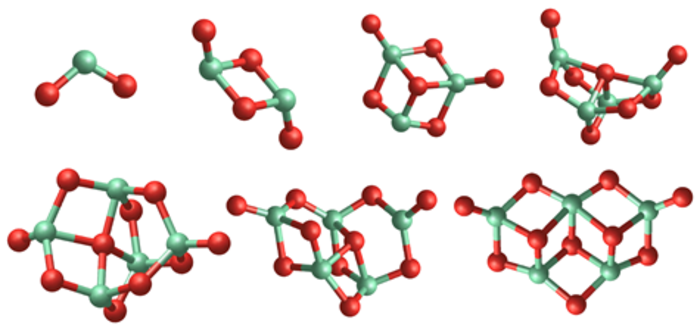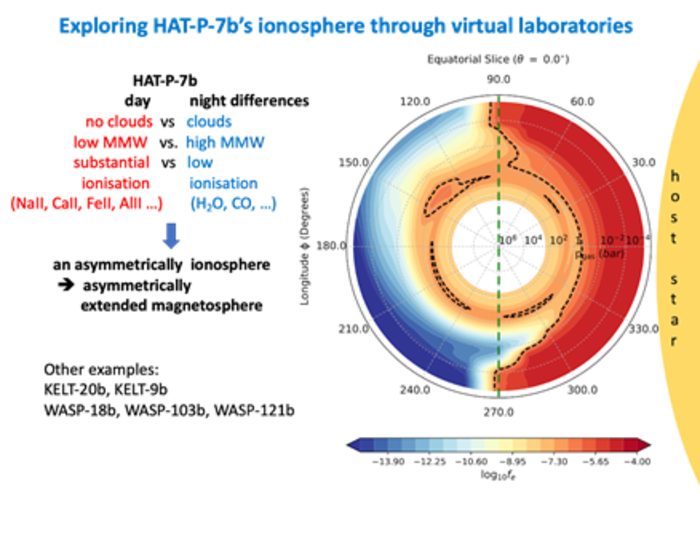Exoplanet Weather and Climate

The discovery of planets outside of the Solar System (exoplanets) has revolutionized our understanding of planet formation and the evolution of planetary systems. It revolutionizes the understanding of humankind and its place in the universe. Recent observations on the ground and in space do now enable the characterization of the atmospheres of exoplanets which came in a large diversity. The understanding of cloud formation is one of the major keys to unravel the diversity of exoplanet atmospheres because they block our view onto the planet of interest. In our solar system, Jupiter, Saturn and Uranus are covered in clouds and it is difficult to impossible to discern what lies beneath them.

Our research group is particularly interested in understanding the weather and climate on extrasolar planets that orbit different host stars (see figure above), how and which clouds form on these worlds, how they affect the local chemical composition and the atmosphere structures. We further investigate how ionisation processes (thermal, high-energy radiation, cosmic rays) affect the local chemistry as well as the cloud particles. We use modells as virtual laboratories that allow us to access unexplored parameters spaces to study the weather and the climate processes on yet unexplored worlds. The fundamental physics and chemistry modelling conducted in our research group is the backbone to enable the data interpretation from space missions like the James Webb Space Telescope (JWST), and in the future PLATO and ARIEL.
Overarching Science Questions that drive our research are:
- How diverse are exoplanets?
- Is our own Solar System special or typical?
- How can we reliably infer exoplanet properties from observations?
- How can we infer the history of exoplanets despite the complexity of the system?
- Could life evolve outside of the Solar System?
Our group develops virtual laboratories, i.e. computer codes, that enable us to combine complex physical processes in order to explore their interplay and to study parameter ranges (like temperature, pressure, radiation field, chemical regimes) that are not accessible by observations nore by laboratory experiments yet. We have joint forces with researchers working on planet-forming disks (including theIWF research group Planet Forming Disks & Astrochemistry) in order to hand on our knowledge to the next generation of researchers within the CHAMELEON network. Our work is enabling the scientific exploration of observational data (Min et al. 2020, Chubb et al. 2020) in preparation of space missions like JWST, PLATO and ARIEL.
Specific topics that our group works at are:
- Kinetic cloud formation in diverse atmospheric environments
- Formation of cloud condensation nuclei in planets other than Earth
- Global cloud distribution
- Ionisation, ionospheres and lightning on extrasolar planets
- Chemical composition of exoplanet atmospheres
We are leading two PLATO work packages:
- Cloud and gas chemistry of planetary atmospheres (WP116700, Lead: Christiane Helling)
- 3D Exoplanet Climates Modelling (WP116800, Lead: Ludmila Carone)
Kinetic cloud formation in diverse atmospheric environments

Bottom row: Three different isomers for cluster size 5.
Of particular interest is the formation of clouds in atmospheres of different exoplanets, the non-equilibrium and kinetic formation of many mixed material cloud particles, made of minerals and metal oxides (such as silicates, corundum, and iron oxide; Woitke & Helling 2003, 2004, Helling & Woitke 2006, Helling et al. 2008). We also explore the effect of turbulence on the cloud formation processes, like through particle-particle collisions causing the cloud particles to charge (Helling et al. 2011) or to grow further to form agglomerates. Our code HyLandS enables now the consistent solution of our microphysical cloud formation and their further growth through turbulent collisions (Samra et al. 2022).
The formation of cloud condensation nuclei in planets other than Earth
For gas-giant planets the first step of cloud formation proceeds by gas-gas reactions. Solid seed particles, so-called cloud condensation nuclei (CCN), are built up through a process called nucleation (Lee et al. 2018, Köhn et al. 2021). These CCN are needed for cloud formation to proceed, therefore it is important to know their formation rates and pathways. In order to do that, this group explores the geometries and thermodynamic properties of small gas-phase clusters for species such as Titanium dioxide and Vanadium oxide, to better understand the role they play in the formation of CCN.
Global cloud distribution
The formation of clouds around exoplanets is not uniform since planets that orbit their host star very closely may have very hot day-side of > 2000 K (e.g., HAT-P-7b, see figure) where no clouds can form. We explore the globale cloud distribution for planets orbiting different host stars based on the results of 3D Global Atmosphere Simulations consistently (Lee et al. 2016, Lines et al. 2018) but also by applying an hierarchical approach (e.g., Helling et al. 2019). Our specific interest is to discern the local cloud properties applying our first-principle micro-physical modelling approach (for a review see Helling 2019).

Ionisation, ionospheres and lightning on extrasolar planets
Exoplanet atmospheres may experience both thermal and non-thermal ionization of the gas phase and the cloud particles. This paves the way for interactions with magnetic fields (Rodrigues-Barrera at al. 2015), which we know from Solar System planets can be complex, as well as for processes such as lightning (Helling et al. 2016, Helling 2019). The study of high-energy radiation reach different atmospheric layers and may enable new chemical processes (cosmic rays: Rimmer & Helling 2013, EUV: Barth et al. 2021). Recent investigations of 3D GCM results suggest, for example for HAT-P-7b and WASP 18b, a deep ionosphere as well of atomic ions like Na+, Ca+, Fe+ or Al+ to be present on the dayside of these planets (see also figure).
The ERC funded LEAP project has enable to start this research.

Chemical composition of exoplanet atmospheres
Planetary atmospheres are the windows into any exoplanets and their chemical composition may be a finger print for the planets evolutionary state, for if clouds are present, and eventually, if there is breathable oxygen. The diversity of exoplanets requires a careful analysis of the atmospheric chemistry before one can jump to any conclusion of the detectable oxygen is in fact breathable or if the detection is a so-called false positive (Woitke et al. 2021). Some of the observed exoplanet atmospheres of gas-giant exoplanets orbit their host star with a period of days. These exoplanets are also tidally locked, so that only one side of the planet permanently faces the star. The intense irradiation of this `dayside’ leads to non-equilibrium photochemistry, as well as stellar energetic particle driven reactions, and reactions due to cosmic rays. These processes are capable of enhancing the formation of certain biomolecules, the precursors to amino-acids such as glycine (Barth et al. 2021).
Other processes that may leave fingerprints are lightning, for example on form of HCN (Hodosan et al. 2016) or or its effect on the NO2 content (Ardaseva et al. 2017). The photochemical rate networks STAND2015 (Rimmer & Helling 2016, 2019) has been developed to simulate the impact of non-equilibrium processes like lightning and radiation from different host stars.
